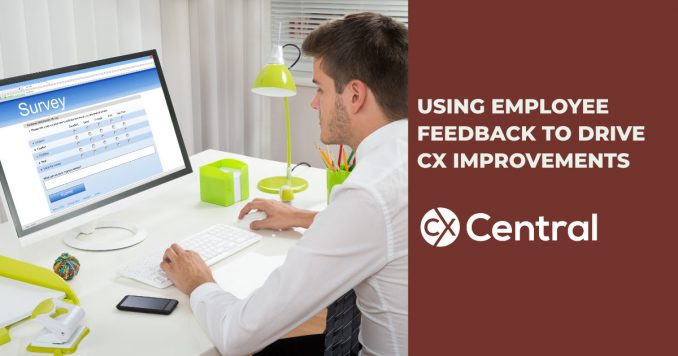
How you can use employee feedback to improve your CX
How the Industrial Revolution drives bad customer experiences
When was the last time you asked someone in your company who actually deals with customers for feedback on what was the most important things that could be done to improve the customer experience they are delivering?
I would estimate based on asking this question to a range of clients that in about 90% of cases, the answer to the above question when asked to middle to senior managers in medium to large companies is either “never” or “a long time ago”.
These front-line employees are the closest to the customer in most cases, hear directly from customers what is working and not working, and normally know exactly what would make their customers’ experiences easier and better.
Their insights should be treated as “gold”, not dismissed or ignored!
In fact, tapping into the insights and perspectives of front-line team members is one of the greatest untapped sources of inspiration, innovation and improvement in customer experience that most companies miss out on utilising either totally, or as much as they should.
In addition, even if individual managers, or companies, do ask front-line employees what needs to be improved, there is often no systematic way for this feedback to be captured, analysed and implemented, especially if they require effort from the broader organisation.
That is, there is no employee feedback or continuous improvement mechanism in place within the company.
Why is this ignoring of front-line insights and lack of feedback so often the case in companies?
Well, the answer to that question is more complicated than you might expect. From my experience, the root cause of this lack of ability for team members to provide meaningful insights, feedback and improvement ideas often embodies a corporate culture that stems from the history of how work environments have been designed, and the role of front-line employees (who are quite often some of the lowest paid in the company) in these environments.
With the onset of the Industrial Revolution in the 18th and 19th centuries, work was often designed into assembly lines, where extremely low-paid workers undertook repetitive, often menial tasks for hours and hour per day, all while working in atrocious conditions and with little if no interaction with anyone else around them.
These workers were not paid to think, they were paid to do.
They were often viewed as almost less than human by their overseers and managers, and were expected to do the same thing over and over again without changing what they did, or (heaven forbid) suggesting ways to do things better.
If they did try and provide feedback, they were often viewed as whingers or complainers.
Whilst we have come a long way since then, there is unfortunately still a significant legacy left over from those times as to how middle and senior managers view their front-line staff.
Too often in conversations with such managers I have heard phrases like “they should just focus on doing their jobs better, “they will just complain”, “they won’’t have any good ideas” or “we know what needs fixing, we don’t need to ask”.
Unfortunately, views like these lead to companies missing out on ideas and innovations that could take the whole company to the next level.
Capturing Employee Feedback to improve your CX
The good news is that things can be done to change the situation, and ensure that frontline employees have a voice and can drive real change in the company.
Of course, the first thing to do is to actually ask for feedback.
Even just doing this is a major step in the right direction.
However, making this effective, long-lasting and impactful requires much broader change in the business.
The changes require often centre around two key things – having a Feedback Culture and implementing a Continuous Improvement Process.
1. Feedback Culture
As already explained, the lack of effective feedback mechanisms often comes down to the lack of a suitable culture in a company.
Amongst other things, the corporate culture needs to exhibit the following facets in order for an employee feedback program to thrive.
A. Empowerment
Front-line employees need to feel empowered to provide feedback, and to make changes they have control over in how they interact with customers.
B. Encouragement
Team members need to be actively encouraged to provide feedback by all levels of management. Feedback needs to be celebrated, not discouraged.
C. Openness
The culture needs to encourage an open sharing of thoughts, ideas and results so that everyone feels they can share their ideas and thoughts.
D. Action-oriented
Employees need to see that suggestions and ideas are turned into action, that real changes occur.
There is nothing worse for team members than providing feedback, only to see it disappear into a black hole and never see actions or the outcomes of the feedback.
Without a culture exhibiting these features, any attempt to implement employee feedback or continuous improvement program is doomed to failure.
2. Continuous Improvement Process
Whilst asking for feedback from team members is a good start, it is critical to have the right processes in place so that the feedback can be captured, analysed and actioned.
This may involve utilising any number of tools (especially in larger-scale companies), or maybe as simple as tracking feedback on spreadsheets and the like.
The processes developed need to facilitate the following broad activities:
- Initial Feedback capture
- Prioritisation of Ideas
- Tracking of progress
- Feedback back to front-line
Building such a process in a sustainable way may not be easy, but is critical to success.
Whilst putting an effective employee feedback and continuous improvement framework in place may sound difficult, the benefits can and will be substantial if implemented effectively.
In fact, having this type of feedback working effectively in a company is a critical pillar for success in driving great customer and business outcomes.
Recommended further reading: 3 Tips for improving employee empowerment in contact centres
If you need some helping capturing and using employee feedback in your business search the free CX Directory for solutions – we’ve got everything from Consultants, CX technology, Mystery Shopping and more.


Be the first to comment